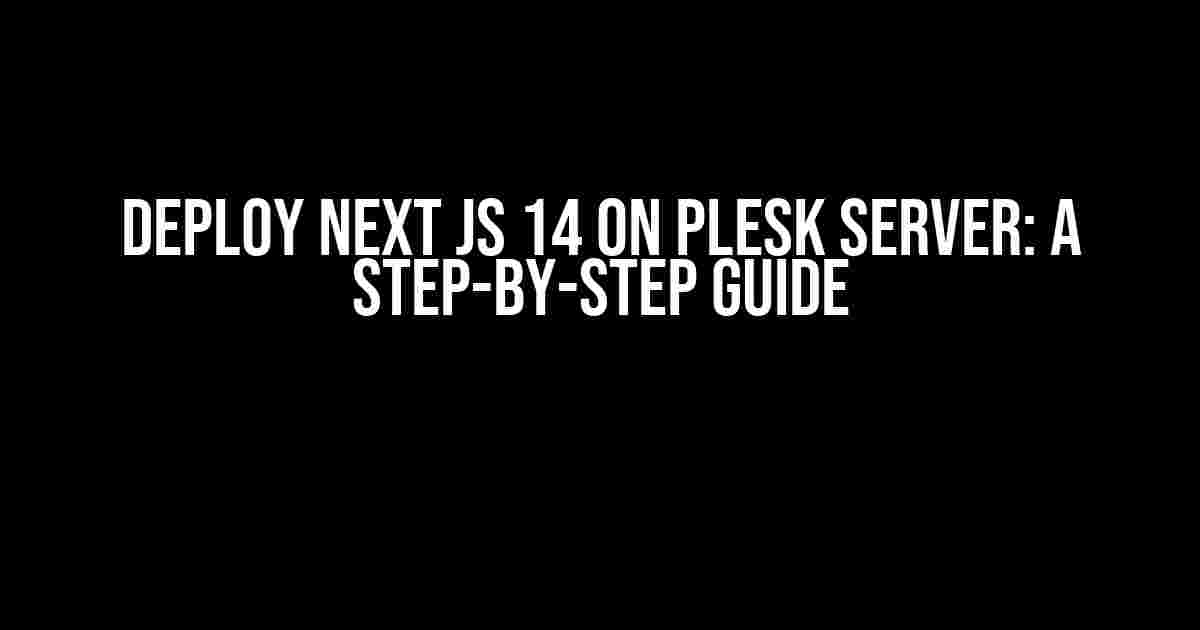Are you tired of struggling to deploy your Next JS 14 application on a Plesk server? Look no further! In this comprehensive guide, we’ll take you through the process of deploying your Next JS 14 app on a Plesk server, step-by-step.
- Prerequisites
- Step 1: Prepare Your Plesk Server
- Step 2: Install Node.js and Required Packages
- Step 3: Configure Next JS 14 for Production
- Step 4: Build and Upload Your Application
- Step 5: Configure Plesk Server for Next JS 14
- Step 6: Configure Plesk Server for Node.js
- Step 7: Start Your Application
- Troubleshooting Common Issues
- Conclusion
Prerequisites
Before we dive into the deployment process, make sure you have the following prerequisites met:
- A Plesk server with SSH access
- Node.js installed on your local machine
- Next JS 14 project setup and ready to deploy
- A code editor or IDE of your choice
Step 1: Prepare Your Plesk Server
Log in to your Plesk server using SSH and create a new directory for your Next JS 14 project:
ssh [email protected]
mkdir nextjs14_project
cd nextjs14_projectCreate a new file called package.json with the following content:
{
"name": "nextjs14_project",
"version": "1.0.0",
"scripts": {
"start": "next start",
"build": "next build"
},
"dependencies": {
"next": "^14.0.0"
}
}Step 2: Install Node.js and Required Packages
Install Node.js on your Plesk server if it’s not already installed:
ssh [email protected]
curl -fsSL https://deb.nodesource.com/setup_16.x | bash -
apt-get install -y nodejsInstall the required packages for your Next JS 14 project:
npm installStep 3: Configure Next JS 14 for Production
In your next.config.js file, add the following configuration:
module.exports = {
//... other configurations ...
production: {
target: 'serverless',
distDir: 'build'
}
}This configuration tells Next JS 14 to use serverless deployment and output the production build in the build directory.
Step 4: Build and Upload Your Application
Run the following command to build your Next JS 14 application:
npm run buildUpload your application files to your Plesk server using SFTP or SCP:
sftp [email protected]
put -r build/ /var/www/vhosts/yourdomain.com/httpdocs/nextjs14_projectMake sure to replace yourdomain.com with your actual domain name and nextjs14_project with your actual project directory.
Step 5: Configure Plesk Server for Next JS 14
Create a new file called web.config in the root of your project directory with the following content:
<?xml version="1.0" encoding="UTF-8"?>
<configuration>
<system.webServer>
<rewrite>
<rules>
<rule name="NextJS" stopProcessing="true">
<match url=".*" />
<conditions logicalGrouping="MatchAll">
<add input="{REQUEST_FILENAME}" matchType="IsFile" negate="true" />
<add input="{REQUEST_FILENAME}" matchType="IsDirectory" negate="true" />
</conditions>
<action type="Rewrite" url="/build/index.html" />
</rule>
</rules>
</rewrite>
</system.webServer>
</configuration>This configuration tells the Plesk server to rewrite all URLs to the index.html file in the build directory.
Step 6: Configure Plesk Server for Node.js
Create a new file called node.config in the root of your project directory with the following content:
<?xml version="1.0" encoding="UTF-8"?>
<configuration>
<system.webServer>
<handlers>
<add name="Node.js" path="*" verb="*" modules="Node" resourceType="Unspecified" requireAccess="Execute" />
</handlers>
</system.webServer>
</configuration>This configuration tells the Plesk server to use Node.js as the handler for your application.
Step 7: Start Your Application
Go back to your Plesk server and navigate to the nextjs14_project directory:
cd /var/www/vhosts/yourdomain.com/httpdocs/nextjs14_projectStart your Next JS 14 application:
npm run startYour application should now be available at http://yourdomain.com.
Troubleshooting Common Issues
If you encounter any issues during the deployment process, refer to the following troubleshooting guide:
| Error Message | Solution |
|---|---|
| Error: Cannot find module ‘next’ | Run npm install to install the required packages. |
| Error: Failed to build application | Check your next.config.js file for any configuration errors. |
| Error: 404 Not Found | Check your web.config file for any configuration errors. |
Conclusion
Deploying a Next JS 14 application on a Plesk server can be a challenging task, but with the right guidance, it can be a breeze. By following this step-by-step guide, you should now have a fully functional Next JS 14 application up and running on your Plesk server.
Remember to optimize your application for production, use a CDN for static assets, and implement caching mechanisms to improve performance.
Happy deploying!
Here are the 5 questions and answers about deploying Next.js 14 on a Plesk server:
Frequently Asked Questions
Get the answers to your most burning questions about deploying Next.js 14 on a Plesk server!
What are the requirements to deploy Next.js 14 on a Plesk server?
To deploy Next.js 14 on a Plesk server, you’ll need a Plesk Onyx or Obsidian version, a Node.js 14 or higher installation, and a compatible operating system (e.g., Ubuntu 18.04 or later). Additionally, ensure your server has enough resources (CPU, RAM, and disk space) to run Next.js 14 smoothly.
How do I create a new Node.js project in Plesk for Next.js 14?
Inside your Plesk control panel, go to the ” Websites & Domains” tab, click on “Node.js” and then “Create a new Node.js project”. Choose the latest Node.js version (14 or higher) and select the “Next.js” project type. Fill in the project details, and Plesk will set up a new Next.js 14 project for you!
How do I configure Next.js 14 to work with Plesk’s built-in Apache or Nginx server?
In your `next.config.js` file, add the following code to configure Next.js 14 to work with Plesk’s built-in Apache or Nginx server: `target: ‘serverless’, assetOptimization: true, experimental: { server: true },`. This setting tells Next.js 14 to use the serverless mode and optimize assets, which is compatible with Plesk’s server configurations.
How do I specify the correct document root for my Next.js 14 project in Plesk?
In your Plesk control panel, go to the “Websites & Domains” tab, click on the “Node.js” section, and select the “Application settings” tab. Set the “Document root” to the `public` folder of your Next.js 14 project (e.g., `/var/www/vhosts/yourdomain.com/httpdocs/public`). This sets the correct document root for your Next.js 14 project.
How do I troubleshoot common issues when deploying Next.js 14 on a Plesk server?
To troubleshoot common issues, check the Plesk error logs, Next.js 14 console output, and browser dev tools for error messages. Ensure your Node.js version, dependencies, and configuration are correct. Also, verify the file system permissions and ownership are set correctly for your project files and directories. If you’re still stuck, check out the official Next.js 14 and Plesk documentation for more guidance!
Let me know if you need anything else!






